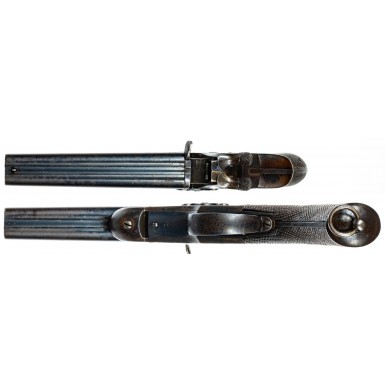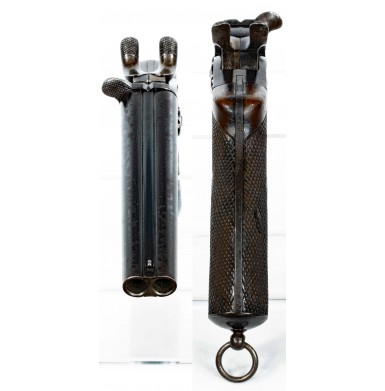Rare Belgian M1877 Nagant Gendarmerie Pistol
- Product Code: FHG-2113-SOLD
- Availability: Out Of Stock
-
$1.00
The name “Nagant” is most often associated with the Model 1895 Russian revolver that bears that name and as the second name in the Russian Model 1891 Mosin-Nagant Rifle. Despite the general assumption by most arms collectors that “Nagant” was a Russian, it is actually the last name of a pair of Belgian brothers, Emile and Leon Nagant. The brothers established an “industrial repair” business in Liège Belgium in 1859 that included the repair of firearms. The business would eventually evolve into a major firearms manufactory, transition to an automobile maker circa 1900 and endure until 1931 before it closed its doors.
The first few years of the business were concentrated upon the repair of various items, including firearms. It is certainly possible that the American Civil War provided an opportunity for business expansion as many of the obsolete arms purchased by US contractors and representatives in Continental Europe were repaired and refurbished in Liège prior to their shipment to America. Sometime around 1867 the Nagant brothers met Samuel Remington during his visit to Europe and entered into a licensing arrangement to produce Remington’s Joseph Rider patent Rolling Block rifle designs. The company’s first major order was for 5,000 Remington Rolling Block patent rifles for the Papal Zouaves. After the successful completion of this contract, the firm continued to produce a wide variety of arms based upon the Rolling Block design. One of the noted issues with the early Rolling Block rifles was the ineffective extractor that was subject to breakage and did not reliably extract cartridges. In June of 1871, the Nagant brothers received a Belgian patent for an improved extractor for the Remington action. The following year they received a Belgian patent for a “firing pin rocker” which essentially created a rebounding firing pin block to prevent accidental discharges. These were significant improvements to the Remington design and made the Nagant produced Rolling Block arms even better. In 1877, the brothers received a patent for single trigger, double hammer lock work that allowed a single trigger to be pulled twice, tripping the right and then left hammer sequentially with each successive pull. While at least one article about Nagant’s Remington patent arms, published in the 1st Quarter, October 2013 Journal of the Remington Society of America claims that this was a major mechanical innovation for firearms design, the author does not consider that John Parker Lindsay received US Patent #30,332 on October 9, 1860, which covered the same mechanical concept. In either case, all three of these Belgian issued patents were utilized together in the design of a new pistol for use by the Belgian mounted police.
The Belgian Model 1877 Nagant Gendarmerie Pistol was a double-barreled, single trigger, double hammer, 9mm center fire metallic cartridge pistol that based upon the Remington Rolling block design. In 1877, the Belgian government extended a contract to the Nagant brothers to produce 2,000 of these pistols and made them the exclusive supplier of police pistols through 1901. While most of the European military and police forces were adopting revolvers, the Belgian Gendarmerie chose to adopt a double-barreled pistol that only provided two shots. Amazingly, these pistols would remain in service through the turn of the century until they were replaced by Browning Model 1899 semi-automatic pistols in 1901.
The double-barreled Belgian Model 1877 Nagant Gendarmerie Pistol was chambered for a proprietary 9.4mm centerfire cartridge that was produced by the Belgian firm Bachman. The pistol had a 5.5” pair of barrels, joined by central rib and was about 10.5” in overall length. The pistols had a somewhat awkwardly shaped, long grip with checkered walnut grips and a lanyard ring in the butt. The pistol were blued with some small parts strawed. The bores were rifled with four lands and grooves of roughly even width. Sights were simple and fixed, with the rear sight being a small notch in the top of the pivoting breech plate and the front sight a small blade. Once the hammers were cocked, it took a very long and heavy trigger pull to release the right hand hammer, while the left hand hammer was released by a somewhat shorter and lighter trigger pull. Standard markings were the Nagant Brothers mark in a circle on the right side of the frame as well as a Nagant patent mark, with Liège proof marks on the barrel. The left side bore a Remington patent marking, and all major components were serial numbered. The police pistols were marked with a large W on the buttcap, indicating issue to the police, rather than with Belgian military unit markings. The guns were carried in pommel holsters on the saddle, thus the holster wear found on extant examples is usually fairly significant and the fact that the leather holsters often absorbed moister from the elements and sweaty horses means that most examples suffer from at least some “poor storage” wear as well. However, with only 2,000 pistols produced, these guns are extremely scarce, particularly on the American firearms collecting market.
Offered here is a VERY GOOD condition example of a Belgian Model 1877 Nagant Gendarmerie Pistol. The gun remains 100% complete, correct and original and has all matching serial numbers. The pistol is serial number 1232, and this mark appears on the left side of the barrel, the barrel web, the frame, both hammers, the breech block, the trigger, the triggerguard, butt cap and inside both grip panels. The right side of the frame is stamped with the circular legend EM & L NAGANT LIEGE and with a small Lion Passant cartouche. It is also stamped under the barrel on the right side of the frame BREVET / NAGANT. The right breech of the barrel is stamped with the oval E / LG / * Liège proof mark, along with a (CROWN) / L controller’s mark and an additional small inspection mark. The controller's mark is found under the barrels as well. The left side of the frame is lightly stamped BREVET REMINGTON, along with serial number on the frame, barrel and barrel web. The bottom of the grip cap is stamped with the serial number and the W police issue marking.
As noted, the pistol remains in about VERY GOOD condition. It retains about 20%+ of the original blued finish, with most of the loss due to wear. The exposed metal has a pleasing dull plum brown patina that blends well with the remaining blue, giving the pistol the appearance of having more remaining blue than it really does. The metal is partially smooth but does show even brownish surface oxidation and light to moderate roughness, particularly along the full-length of the tops of the barrels. As mentioned, this is likely from the carry in pommel holsters. There is also scattered pinpricking and light pitting here and there. The markings on the gun remain mostly clear and legible, with the weakest and least legible mark being the “Brevet Remington” mark on the left side of the frame. The butt cap markings are weak, as are a couple of the serial numbers. This is all from wear and use as well as surface oxidation. The pistol is perfect mechanical condition and the action remains FINE and crisp. The bores of the pistols are FINE as well, they are mostly bright with scattered even frosting and some light oxidation in the grooves. The grips remains in VERY GOOD condition as well. The grips are solid and free of any breaks, cracks or repairs. The grips do show scattered bumps and dings and one more moderate ding in the middle of the right grip panel.
Overall, this is a solid, attractive all complete and correct example of a Belgian Model 1877 Nagant Gendarmerie Pistol. These are scarce guns with only 2,000 manufactured and these days are fairly rare on the collector market. They fall into multiple handgun collector categories, including police pistols, secondary Remington handguns and rolling block firearms, Nagant pattern arms and curiosa, as double-barreled cartridge pistols like this are somewhat uncommon. No matter what your area of collecting, this is a relatively uncommon pistol with a unique silhouette which will certainly be a nice addition to your collection.
SOLD









